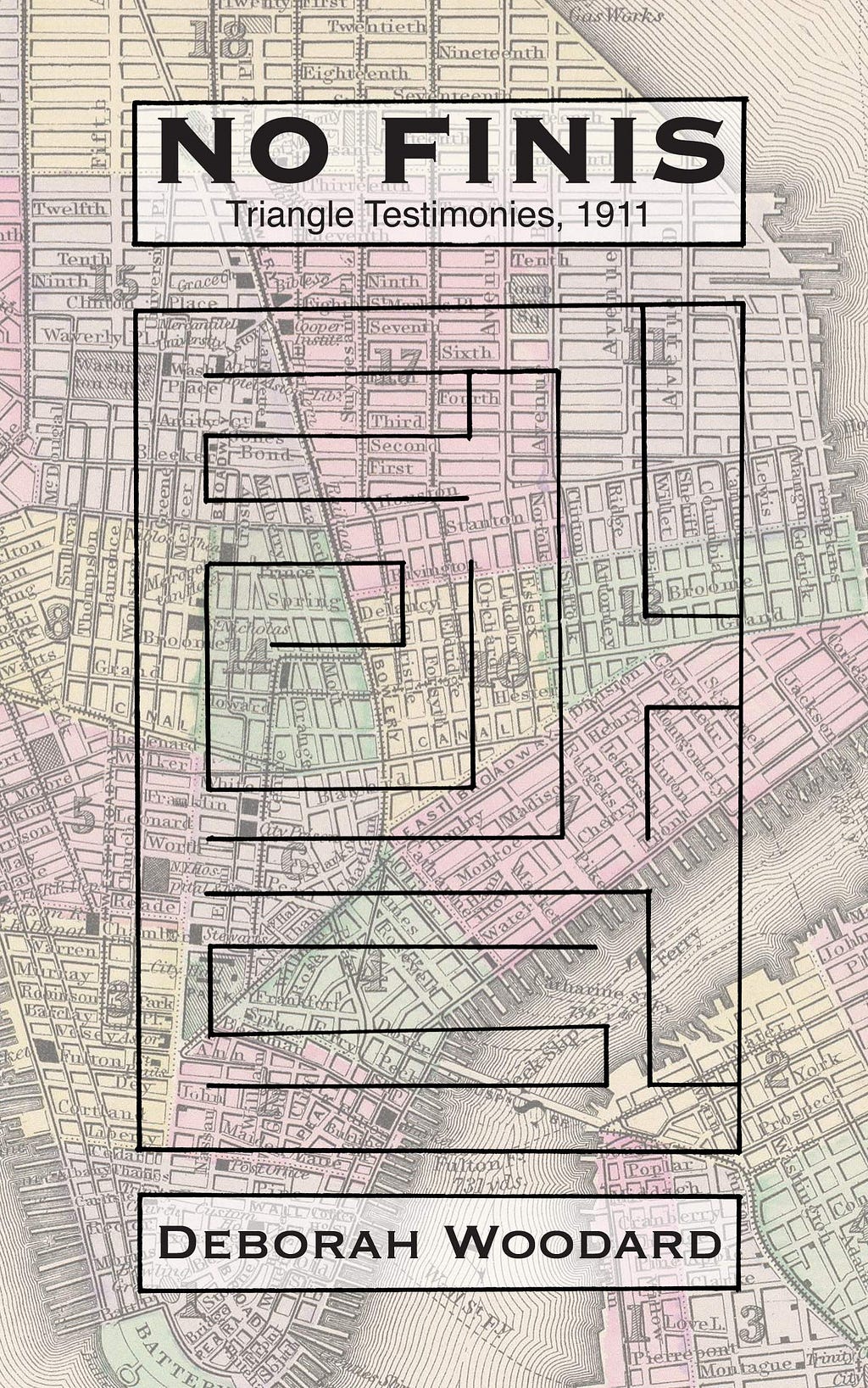
For whatever reason, one of the few things I retained from high school history class was the story of the Triangle Shirtwaist Factory fire of 1911. Nearly 150 people died, and the event helped usher in better building codes and working conditions in America. The event has stuck around in my head for 20+ years, the memory of all those women in a hot, crowded factory, a crummy job leading to a cruel end.
When I heard about Deborah Woodard’s No Finis: Triangle Testimonies, 1911, I got excited. Poets who form collections around historical events (Teow Lim Goh, Mariko Nagai) always fascinate me. They seem to haunt these events they write about, the poems circling, circling, like ghosts moving around a place or icon that hasn’t lost its hold on a soul. I write essays like that, but I’m incapable of poetry. I wish I could insert “haunted collection” ideas into poets’ heads: write about Chernobyl, Carl Phillips. Write about Atlantis, Carolyn Forché. And here is a collection about one of those flukey historical events, one I remembered and very much wanted to read poetry about.
The poems in No Finis are collages, narrative snippets cut and pasted to make century-old voices ring out plainly. Woodard delves into the transcript of a trial that resulted from the fire (the two men who owned the factory were charged with just one of the 146 deaths), and she plucks out testimony to rearrange and present. Each poem is a portion of this testimony. From “Mr. Steuer and Rose Mayers,” for example:
A door that was locked with keys, you went to open with your hands?
Not only me, about fifty of us.
You cannot tell us any girls that tore at the door, can you?
One girl by the name of Jennie. She used to give out the laces.
The nature of reading changes depending on how a text is presented, of course. Presented as a poem, this trial testimony gains enormous gravitas; every word drops on the reader like a small stone. “She used to give out the laces” is ordinary in one light, slipping by as a practical description, and yet it has a rhythm and a meaning that appeals to the ear and the heart more than most lines of trial testimony do. “The laces,” objects that have significance to Rose but not to the reader, or potentially to the examining attorney, Mr. Steuer. “Used to,” meaning that does not happen anymore, either because Jennie is dead, or because Rose no longer works at the factory, or both.
The language sometimes veers into the strange. “I see the fleck of a supposition, like the sweet taste of an old apple,” Mr. Steuer muses in “Anna Gullo, Recalled to the Stand.” “The tree uncooped its birds!” he exclaims in “Mr. Steuer and Katie Weiner.” “I dream two scars where the wings should be. I see the mechanical up and down of the feathers each time I breathe,” Ida Okan testifies, in “Mr. Steuer and Ida Okan.” But for the most part, the testimony is matter-of-fact (if awful):
Isn’t it a fact that you were excited and didn’t know what you were doing?
I had in mind my sisters and couldn’t look at the things around me.
Did you cry out for your sisters, then?
Yes, the younger one. The older one was sitting far away.
In her Foreword, Woodard writes a short history of the fire and then offers a little information about her method: “I compressed representative cross-examinations and added in a few fictional threads that seemed indicative of the state of mind of the witnesses, and sometimes of Steuer, as well. The source material…contributed its own oddities.” I cannot tell from this statement whether the weird turns of phrase that sometimes occur in No Finis are part of the original testimony or part of Woodard’s craft, or if it varies. Such uncertainty is likely great and good for poets, but for readers like me it is torture. Tell me what’s what. I must know.
The book also bears a series of ten images by John Burgess, “Testimony,” each a hand-drawn diagram of some element of the Triangle fire. These drawings are explained in the back of the book. I remain unsure about their contribution to No Finis; they are not visually arresting, nor are they obvious or symbolic, for the most part. Only one, depicting 146 hand-drawn, numbered rectangles, felt distinctly impactful. The rest required their captions.
Each poem bears a final line, following a break, that is the least sensible, most poetic part of the poem. They feel like snippets of thoughts, rather than testimony: “mechanically she gripped the air’s one rung,” “the wishbone is a hinge,” “alone, there were many people there, but I came alone.” I wanted to assemble all these lines into a single poem, to collage this collection of collages. They spoke to me so much more than the rest of the poems, which fell strangely flat. I don’t think every reader will feel this way — it’s a subjective review — but I wanted something else than what this collection happens to be. Something which seizes this one horrific day 108 years ago and from it, drew big, unpredictable lines of flight in the sky.
Woodard has created a restrained, ultimately unknowable collection from existing materials, and that is a work of craft I admire, and can recommend. But whatever part of me chose to hang on to this event from history class, when so many others have fallen away forever, desired a true haunting.
Century-Old Voices: A Review of Deborah Woodard’s No Finis was originally published in Anomaly on Medium, where people are continuing the conversation by highlighting and responding to this story.
